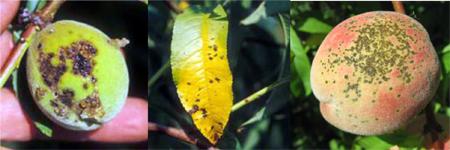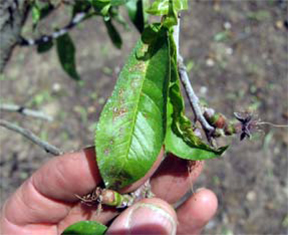Management of bacterial spot on peach and nectarines
Editor’s note: This article is from the archives of the MSU Crop Advisory Team Alerts. Check the label of any pesticide referenced to ensure your use is included.
Bacterial spot is an important disease of peach, nectarine, apricot and plum caused by Xanthomonas campestris pv. pruni (also known as Xanthomonas arboricola pv. pruni). Symptoms of this disease include fruit spots, leaf spots and twig cankers. Fruit symptoms include pitting, cracking, gumming and water-soaked tissue, which can make the fruit more susceptible to brown rot, rhizopus and other fungal infections. Severe bacterial spot infections on leaves can cause early defoliation. Severe defoliation can then result in reduced fruit size, and sunburn and cracking of fruit. Early defoliated trees are reduced in vigor and winter hardiness.
Fruit symptoms of bacterial spot may be confused with peach scab, caused by the fungus Cladosporium carpophyllium; however, scab spots are more circular, have a dark brown-greenish, fuzzy appearance, and do not pit the fruit surface. Scab does not cause leaf symptoms but can cause spots on twigs. Initial fruit spots of bacterial spot may be superficial but can later develop into craters.
Leaf symptoms of bacterial spot on peaches and nectarines are generally dark, small lesions, often clustered at the leaf tip where water collects during dews and rain. Leaf tissue around lesions can turn yellow.
The bacterial spot pathogen overwinters in dark, gummy branch tips and diseased twigs. Removal of gummy tissue during spring pruning may help to reduce inoculum levels. Bacterial spot symptoms on leaves generally are not seen until after bloom, but onset can occur earlier if conditions are highly favorable. Fruit are highly susceptible when exposed after shuck split and the susceptibility is reduced after pit hardening in mid- to late June. However, a high amount of leaf infection and warm wet conditions can cause the continuation of fruit infections after pit hardening. A few weeks before harvest, fruit becomes more susceptible to bacterial spot infection, however, these later-occurring symptoms are more superficial.
Bacterial spot is favored by hot, dewy, wet conditions, and windy, sandy sites. Spread and entry of the bacterial spot pathogen into plants is favored by abrasions and nicks caused by blowing sand, especially common on outside peach rows next to dirt roads. Spraying trees when foliage is wet from rain or dew may help to spread bacterial spot.
A variety with moderate resistance to bacterial spot may perform adequately in a site sheltered from wind and look terrible in a bacterial spot-prone site. There is a significant “Typhoid Mary” effect for bacterial spot – a highly susceptible variety can serve as a source of infection for surrounding trees. One disease management strategy is to “hide” more susceptible varieties on the inside of orchard blocks with the most resistant varieties on the exposed orchard edges. The susceptibility to bacterial spot is not known for many new varieties (see MSU Michigan Fruit Management Guide E-154 for the current list). Another strategy is to establish sod strips between trees and to use gravel or other dust-suppressing methods on nearby dirt roads.
Bacterial spot is a difficult disease to control. As with all bacterial plant diseases, there are relatively few bactericide chemicals available for use. Compounds available for use on peach and nectarine for bacterial spot include copper, oxytetracycline (Mycoshield and generic equivalents), and Syllit+captan; however, repeated applications are typically necessary for even minimal disease control.
Oxytetracycline is generally considered the most effective compound and the least prone to phytotoxicity problems (damage to plant tissue), but also perhaps most likely to lose effectiveness with the appearance of bacterial strains with resistance. There is some evidence that the hydrochloride form of oxytetracycline (Fireline) is more effective than the calcium form Mycoshield.
Syllit+captan is used as a moderately effective alternative to oxytetracycline, but with some risk of phytotoxicity if used repeatedly without intervening rains. We avoid the use of spray additives such as foliar nutrients, and any surfactants with penetrating characteristics when applying Syllit + captan.
Copper provides a third alternative for bacterial spot control where needed but with a somewhat greater risk of phytotoxicity. Copper compounds differ in their metallic copper content and labeling for use. The application strategy, developed at North Carolina State University, is to use a decreasing copper dose starting at first green tissue and ending shortly after shuck split. Use of copper will generally cause at least some damage to leaves. The safety margin is relatively small. Copper is toxic when the dissolved form penetrates into plant tissue.
In general, growers should avoid the use of spray additives such as spray oils, foliar nutrients, and any surfactants with penetrating characteristics when applying coppers. Careful calibration and adjustment of spray equipment is needed to make sure applications do not result in excessively high deposits of copper in some areas of the trees. Careful monitoring of copper-treated orchards for foliage phytotoxicity should be done before copper is reapplied.
Some, but not all, copper compounds are labeled for use on peaches and nectarines after bloom. Peach fruit are generally much more resistant than foliage to copper damage. The relative sensitivity of nectarine fruit to copper has not been tested by Michigan State University. Labels for use of copper compounds on apricots and plums are generally more restrictive than for peaches and apricots.
Table 1. General program for in-season use of copper for bacterial spot suppression on peaches and nectarines (modified from summary by David Ritchie, North Carolina State University).
| Stage | Formulated 53%copper (lb/acre)* | Metallic copper (lb/acre) |
| Delayed dormant | 4 to 5 | 2 |
| 7 to 10 day interval | 2 | 1 |
| 1 to 5 to bloom | 1 | 0.5 |
| Petal fall | 0.5 | 0.25 |
| Shuck split | 0.25 | 0.125 |
| After shuck split switch to Mycoshield or Syllit + captan | ||
* Example given is for 53 percent fixed copper, if other formulations are used,
use at the same metallic copper per acre rate. If you have not had a rain since
the last copper, hold off or skip the next application. Apply no sooner than weekly.
Look for signs of copper injury and the amount of copper residue before each application. If copper is obvious on the foliage, hold off. If the amount of copper damage is becoming significant, hold off.
Table 2. Copper product summary; check label for allowed use on crop. (click to view pdf)



 Print
Print Email
Email






